Evatran has successfully completed the first three installations of its Plugless Power wireless electric vehicle (EV) charging technology with Apollo Launch partners The Hertz Corporation, Duke Energy, and the Clemson University International Centre for Automotive Research (CU-ICAR). It is claimed that these installations, on Nissan Leaf vehicles, represent the first passenger electric vehicles in the world with full wireless charging capability.
July 23, 2012
Read time: 2 mins
Drivers at the three installation locations have been trialling the vehicles for the past month, since installations began in early June, and will continue to test the systems throughout the next three months. An additional three installations will be completed imminently with partners from California to Washington, DC. The Apollo Launch programme follows six commercial partners as they trial wireless charging technology installed on their own Chevy Volt and Nissan Leaf vehicles, in a variety of real-world applications.
"Our goal in launching this one-of-a-kind initiative was two-fold," explains Tom Hough, Evatran's CEO and an electric vehicle driver, "We wanted to get this game-changing technology into the hands of real electric vehicle drivers and we wanted to show the market that convenient, wireless charging technology can encourage electric vehicle adoption on a large scale."
The plugless power technology is based on electromagnetic induction, a technology that has been understood for over 100 years. This fundamental technology was enhanced by Evatran engineers with proprietary control software and coil designs in order to extend the efficient transfer of power over an air gap of as much as seven inches.








